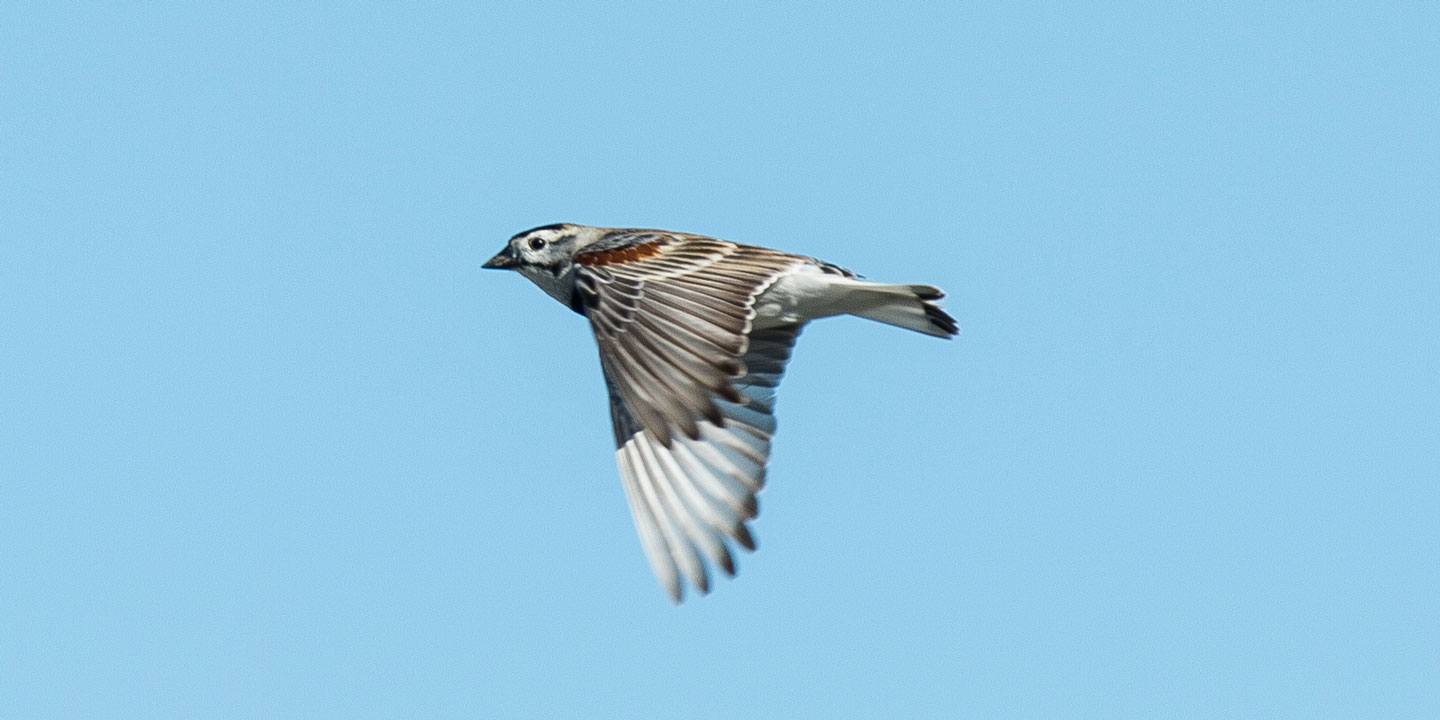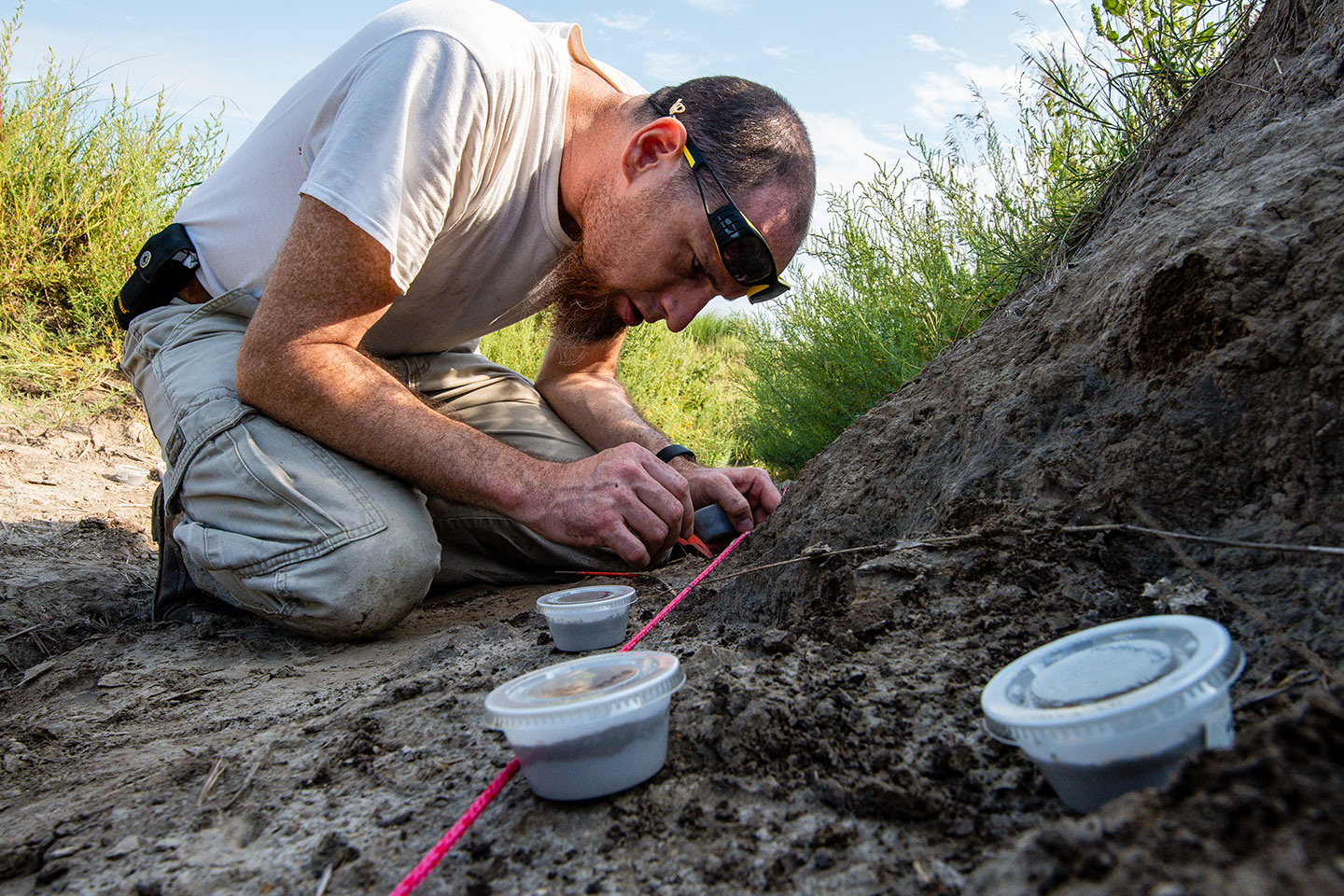Thick-billed longspur
Status: Threatened

The thick-billed longspur (Rhynchophanes mccownii) is migratory bird that occurs in the wide expanses of high-plains shortgrass prairie located west of the Sandhills in the Panhandle of Nebraska. The average size of thick-billed longspur is 15 cm (6 in) long with a wingspan that can reach 28 cm (11 in). Male and female longspurs have white outer tail feathers with dark central feathers forming an inverted T-shape. A male longspur is distinguished by a black crown on the top of its head, black whisker markings below the eye, chestnut-colored wing bar, and a black band across the upper breast. A female longspur is duller in color and more streaked. The thick-billed longspur has a large, conical bill that is stouter than other longspur species.
In Nebraska, thick-billed longspurs are a spring and fall migrant in the western Panhandle and breed locally in Kimball, Banner, and Sioux counties. Spring migrating longspurs typically arrive in mid-April and fall migrants leave the state in late October or November. Thick-billed longspurs winter in the southwestern United States and can be found as far south as northwestern Mexico.
The thick-billed longspur was formerly known as the McCown’s longspur, but its common name was changed in 2020 by the American Ornithological Society.
Range
Southern limit of the breeding range is in east-central Colorado, and the northern limit extends into the Canadian provinces of Saskatchewan and Alberta. Thick-billed longspurs winter in the southwestern United States, primarily including western Texas, Oklahoma, New Mexico, and northwestern Mexico, ranging into the grasslands of the Chihuahuan Desert.
The species breeding range in Nebraska encompasses two large areas in the state—the southwestern Panhandle including most of Kimball and southern Banner counties and the prairies of central and southern Sioux County. Within Nebraska, as in nearby Wyoming, thick-billed longspurs nest in localized areas likely because of the patchy distribution of suitable habitat.
Diet
The thick-billed longspur feeds on grass, forbs, seeds, and insects such as grasshoppers, beetles and moths.
Habitat
Thick-billed longspur prefers vast open areas in the western Great Plains, breeding in moderately to heavily grazed native shortgrass prairie. Other common shortgrass prairie bird species include the chestnut-collared longspur, horned lark, burrowing owl, and the Nebraska state-listed threatened mountain
plover.
Thick-billed longspurs often nest in habitats dominated by loamy soils with short-stature warm season grasses such as blue grama (Bouteloua gracilis) and buffalo grass (Bouteloua dactyloides) in the southern portions of their range. Territories and nest sites are often located on level areas at a higher elevation than the surrounding landscape, such as areas described as “flat-topped prairie benches”. During the non-breeding season, this species occupies similar areas as during the breeding season, but habitat use is more flexible and includes agricultural fields in addition to native prairie.
Reproduction
Thick-billed longspurs arrive in Nebraska for the breeding season around April of each year. Males establish territories from which they perform aerial displays and sing to perform courtship displays. Nest sites are chosen by the females and are often located near a microhabitat feature such as a clump of grass, small shrubs, or cattle dung. The actual nests are simple depressions located on the ground lined with grasses and other plant materials.
A female thick-billed longspur lays 2 to 5 white to olive-colored eggs that hatch approximately 12 days after incubation. Young longspurs are dependent on parents for 3 weeks and primarily feed on insects by the female. At around 7-11 days young will leave the nest, and the parents may commence a second nesting attempt if conditions are suitable. Thick-billed longspurs are typically monogamous, meaning they will have only one mate at a time.
Population status
Due to broad alterations of their habitat, thick-billed longspur populations have exhibited drastic declines throughout their range. Habitat loss occurs when native prairie is converted to another type of land use, such as row crop agriculture. This can also occur when small areas within a broader landscape are developed into roads or energy development infrastructure, such as oil, gas, or wind turbines. Loss and fragmentation of extensive areas of native shortgrass prairie has been detrimental to the wintering range of thick-billed longspurs.
Predation by other animals is a source of adult mortality, loss of nests, and nestling mortality. Common predators of thick-billed long spur include ground squirrels, owls, hawks, badgers, skunks, foxes and snakes.
Management and outlook
The overwhelming majority of thick-billed longspur habitat in Nebraska is privately-owned and ranching operations are commonplace. Working with landowners to preserve and conserve native unfragmented mixed-grass and short-grass prairie habitat as working grazing landscapes is a straightforward action that will minimize additional population declines. Grazing strategies such as well-timed cattle grazing and rotations that maintain patches of bare ground and short sparse vegetation during the breeding season is vital.
Conservation help
Although there have been small-scale research studies focused on thick-billed longspur, there are additional information needs. A few of the information gaps include breeding distribution and numbers, and what possible long-term effects may be impacting breeding habitat due to differing management strategies on the landscape. Thick-billed longspur breeding birds are functionally connected to the population in Wyoming, Colorado and throughout the Great Plains. However, obtaining a meaningful and reliable estimate of those birds located within Nebraska will help identify areas of conservation priority.
References
Brenner, S.J. and J.G. Jorgensen. 2022. Elevation and soils explain thick-billed longspur’s breeding distribution in northwestern Nebraska. Joint Report of Audubon Nebraska and the Nongame Bird Program at the Nebraska Game and Parks Commission.
Jorgensen, Joel G., Stephen J. Brenner and M.J. Panella. 2022. A Thick-billed Longspur & Chestnut-collared Longspur Conservation Strategy for Nebraska. Version 1.0 (October 2022). Joint report prepared by the Nebraska Game and Parks Commission and Audubon Nebraska, Lincoln and Gering, Nebraska.
American Ornithological Society (AOS). 2020. Statement on the McCown’s Longspur Naming Issue.
Statement of the American Ornithological Society, 30 June 2020. Accessed Dec. 1, 2021.
NOTE: New data of the occurrence and distribution of this species are being collected constantly and some of the information in the pamphlet may be outdated. The information in this pamphlet should be used for a general understanding of the species and not as the sole source of range location for any report, project, regional or local planning, or for environmental impact assessments. For current information on this species, please contact the Nebraska Game and Parks Commission, Wildlife Division.




